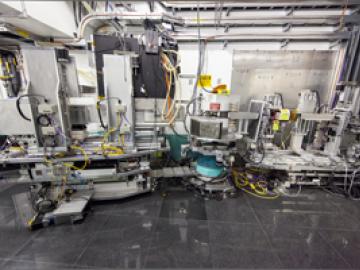
Filter News
Area of Research
- Advanced Manufacturing (2)
- Biological Systems (1)
- Biology and Environment (36)
- Biology and Soft Matter (3)
- Building Technologies (3)
- Chemical and Engineering Materials (2)
- Chemistry and Physics at Interfaces (4)
- Clean Energy (36)
- Climate and Environmental Systems (4)
- Computational Chemistry (4)
- Computational Engineering (1)
- Computer Science (2)
- Earth Sciences (1)
- Electricity and Smart Grid (1)
- Energy Frontier Research Centers (4)
- Fuel Cycle Science and Technology (1)
- Functional Materials for Energy (7)
- Fusion and Fission (11)
- Isotopes (1)
- Materials (31)
- Materials for Computing (9)
- Materials Synthesis from Atoms to Systems (5)
- Materials Under Extremes (4)
- National Security (21)
- Neutron Data Analysis and Visualization (2)
- Neutron Science (7)
- Nuclear Science and Technology (3)
- Quantum Condensed Matter (2)
- Renewable Energy (1)
- Sensors and Controls (1)
- Supercomputing (37)
- Transportation Systems (3)
News Type
News Topics
- 3-D Printing/Advanced Manufacturing (4)
- Advanced Reactors (1)
- Artificial Intelligence (7)
- Big Data (5)
- Bioenergy (16)
- Biology (19)
- Biomedical (3)
- Biotechnology (2)
- Buildings (5)
- Chemical Sciences (7)
- Clean Water (2)
- Climate Change (21)
- Composites (1)
- Computer Science (12)
- Coronavirus (3)
- Critical Materials (1)
- Cybersecurity (5)
- Decarbonization (15)
- Energy Storage (11)
- Environment (28)
- Exascale Computing (4)
- Frontier (5)
- Fusion (6)
- Grid (3)
- High-Performance Computing (10)
- Hydropower (3)
- Isotopes (1)
- ITER (1)
- Machine Learning (5)
- Materials (15)
- Materials Science (10)
- Mercury (1)
- Microscopy (8)
- Nanotechnology (5)
- National Security (9)
- Net Zero (2)
- Neutron Science (4)
- Nuclear Energy (7)
- Partnerships (2)
- Physics (4)
- Polymers (1)
- Quantum Computing (5)
- Quantum Science (3)
- Security (3)
- Simulation (4)
- Space Exploration (1)
- Summit (5)
- Sustainable Energy (14)
- Transformational Challenge Reactor (1)
- Transportation (5)
Media Contacts


Oak Ridge National Laboratory researcher John Wagner has been named a 2013 recipient of the Department of Energy’s Ernest Orlando Lawrence Award for his work in advancing computer, information and knowledge sciences.







ITER, the international fusion research facility now under construction in St. Paul-lez-Durance, France, has been called a puzzle of a million pieces. US ITER staff at Oak Ridge National Laboratory are using an affordable tool—desktop three-dimensional printing, also known as additive printing—to help them design and configure components more efficiently and affordably.

Photovoltaic spray paint could coat the windows and walls of the future if scientists are successful in developing low-cost, flexible solar cells based on organic polymers. Scientists at the Department of Energy’s Oak Ridge National Laboratory recently discovered an unanticipated factor in the performance of polymer-based solar devices that gives new insight on how these materials form and function.


